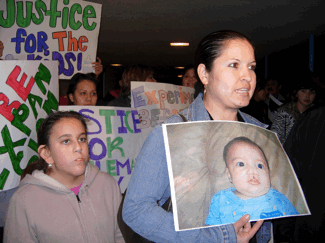Hispanic Community Fights Toxic Waste
Air Date: Week of February 12, 2010
Mothers of children born with cleft palate protest the expansion of a toxic waste landfill. (Photo: Zaidee Stavely/Radio Bilingue)
In the small town of Kettleman City, California, residents recently met with public health officials to discuss if a nearby toxic waste facility would be granted a permit for expansion. Community members are fighting this permit, claiming that a recent increase in birth defects is a result of toxic waste from the facility. Zaidee Stavely has been covering the story for Radio Bilingue and talks with host Jeff Young.
Transcript
[CROWD CHANTING]
YOUNG: Kettleman City, California wants answers. Babies in the poor and largely Latino town are being born with deformities and residents want to know why. Many of the 1,500 residents work in agriculture or service jobs. The town lies about halfway between San Francisco and Los Angeles. It’s a common stopping point for travelers on Interstate Five. The town’s other major employer is a sprawling chemical waste site.
For decades Kettleman City residents have fought Chemical Waste Management over proposed expansions of its landfill. The dispute has included charges of environmental racism and repeated concerns that the toxic dump is causing health problems. Now, people suspect chemical waste is to blame for the recent spike in birth defects.
Five area babies born in a 15-month period in 2007 and 2008 suffered severe birth defects -- including cleft palate, heart problems and developmental delays. Maria Saucedo, a 17-year resident of the area, gave birth to one of those children--a daughter named Ashley.
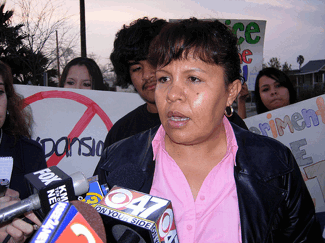
Maria Saucedo speaks with journalists in Kettleman City after the EPA visit. (Photo: Zaidee Stavely/Radio Bilingue)
[SAUCEDO SPEAKING SPANISH]
VOICEOVER: When Ashley was born, they told me she would make it a month. She wouldn't live to two months. But time passed and Ashley was five, six, seven months. I thought that she would be with me longer. But when she got to be ten-months-old I could see that what they told me was true - that she was going to die, and she did.
YOUNG: Maria Saucedo was among the residents who crowded a recent emotional meeting in Kettleman City. Health officials shared preliminary results of an investigation of the birth defects and possible causes. Reporter Zaidee Stavely with Radio Bilingue was at that meeting. She’s also visited the chemical waste facility, which covers some 1,600 acres.
STAVELY: The Chemical Waste Management facility there in Kettleman Hills is the largest toxic waste landfill in the Western United States. It takes paints, oils; it’s actually the only facility in the state that is allowed to take PCBs.
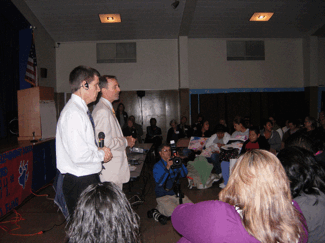
California public health officials meet with concerned residents.(Photo: Zaidee Stavely/Radio Bilingue)
The liquid PCBs there are washed out of old transmitters from telephone lines and florescent tubes, and the metal containers are dumped there in the landfill in Kettleman City. You go in and it’s basically just hills upon hills of landfill. It’s hard to distinguish between the natural mountains of the area and dirt mounds that are covering old landfills. And it’s both a regular garbage dump and also a hazardous waste landfill. So you have several different sections and it’s thousands of acres.
YOUNG: What evidence is there that the Chemical Waste facility is causing contamination?
STAVELY: There is no evidence at this point that there’s actual contamination from the hazardous waste landfill into the town. And the landfill representatives say that there have been several studies that show that they do not affect the health of the community. The community members and their environmental allies say that those studies were not intensive enough and the company’s not being scrutinized enough.
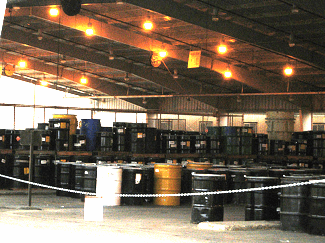
Vats of toxic waste at the landfill at the 1,600-acre Kettleman Hills landfill, owned by Waste Managment. (Photo: Zaidee Stavely/Radio Bilingue)
YOUNG: However they did find some evidence of some tainted drinking water, correct?
STAVELY: Yes, drinking water quality for the past several years has been found tainted; there’s high levels of arsenic in the water, and there has been in the past high levels of benzene, as well in the water. They think that the benzene could possibly be from past oil operations in the area. I know that also benzene is more frequently occurring near hazardous waste landfills.
YOUNG: Now, what do we know about the possible links between the kinds of birth defects that people are suffering in Kettleman City and the potential exposure to the kinds of chemicals that are in that facility?
STAVELY: There’s several studies that show that certain birth defects are more common in the vicinity of hazardous waste landfills. Unfortunately, it’s not clear why.
YOUNG: There are other risk factors that could be associated with these kinds of birth defects. I gather the public health officials tried to communicate those, but it didn’t go over very well.
STAVELY: Yes, the public health officials included in their handout a section called “Possible Causes of Birth Defects” and they did not include there any environmental risk factors. They mentioned instead use of alcohol, smoking tobacco, use of medication, and poorly controlled diabetes.
And many of the people in the town that were there at the meeting (and especially the mothers) were very upset by this. They felt that the public health officials were blaming them without ever having done interviews with them and that they were discounting an environmental factor without every having done environmental testing.
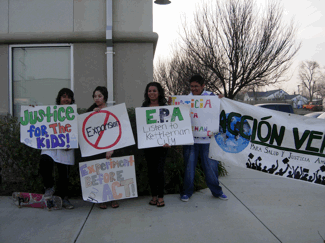
Young folks in Kettleman City urge the EPA to keep the toxic waste landfill from expanding. (Photo: Zaidee Stavely/Radio Bilingue)
YOUNG: What did the people of Kettleman City learn from this meeting?
STAVELY: The department of public health presented some of their preliminary results and public health officials looked at statistics from 1987 to 2008, and included birth defects from the entire period and said that the total number over the 22-year period in Kettleman City was not unusual.
Community members wanted more answers and the public health officials did say that in 2008 it did look like there was a spike in birth defects – that in 2008 they found four, which they say that in such a small town they would be expecting a range of between zero and three birth defects. Four seemed in excess they said and that’s why they want to investigate further.
YOUNG: You caught a moment where community members confronted the public health officials about that apparent discrepancy in the data. Let’s hear a bit of that:
[MAN SPEAKING SPANISH]
TRANSLATOR: Don’t you think that four birth defects out of 50 or 60 is a very high percentage?
RILEY: Yes, we think that four birth defects in 2008, that’s higher than had been happening in the 21 years before.
YOUNG: That was California public health official Dr. Rick Kreutzer, he promised further study – how did residents respond to that?
STAVELY: That promise was very well received. Community members and also mothers said, thank you, that’s what we want, we’re so glad the public health department is finally in our community after 50 months of asking for an investigation. And the community members were insistent that the public health department also look into environmental risk factors.
YOUNG: And the company here, Chemical Waste, they want to get bigger, right?
STAVELY: Yeah, exactly. Chemical Waste Management wants to expand their hazardous waste landfill. They say that if they don’t expand, their landfill is going to have to close and instead they’ve asked for an expansion of something around 63 acres of an extra hazardous waste landfill, which would give them another 30-odd years.
The community is pretty upset about this, as well, and they have asked that the government stop giving the company permits until this investigation of the birth defects is complete.
YOUNG: Zaidee Stavely with Radio Bilingue. Thank you.
STAVELY: Thanks, Jeff.
Living on Earth wants to hear from you!
Living on Earth
62 Calef Highway, Suite 212
Lee, NH 03861
Telephone: 617-287-4121
E-mail: comments@loe.org
Newsletter [Click here]
Donate to Living on Earth!
Living on Earth is an independent media program and relies entirely on contributions from listeners and institutions supporting public service. Please donate now to preserve an independent environmental voice.
NewsletterLiving on Earth offers a weekly delivery of the show's rundown to your mailbox. Sign up for our newsletter today!
 Sailors For The Sea: Be the change you want to sea.
Sailors For The Sea: Be the change you want to sea.
 The Grantham Foundation for the Protection of the Environment: Committed to protecting and improving the health of the global environment.
The Grantham Foundation for the Protection of the Environment: Committed to protecting and improving the health of the global environment.
 Contribute to Living on Earth and receive, as our gift to you, an archival print of one of Mark Seth Lender's extraordinary wildlife photographs. Follow the link to see Mark's current collection of photographs.
Contribute to Living on Earth and receive, as our gift to you, an archival print of one of Mark Seth Lender's extraordinary wildlife photographs. Follow the link to see Mark's current collection of photographs.
 Buy a signed copy of Mark Seth Lender's book Smeagull the Seagull & support Living on Earth
Buy a signed copy of Mark Seth Lender's book Smeagull the Seagull & support Living on Earth

